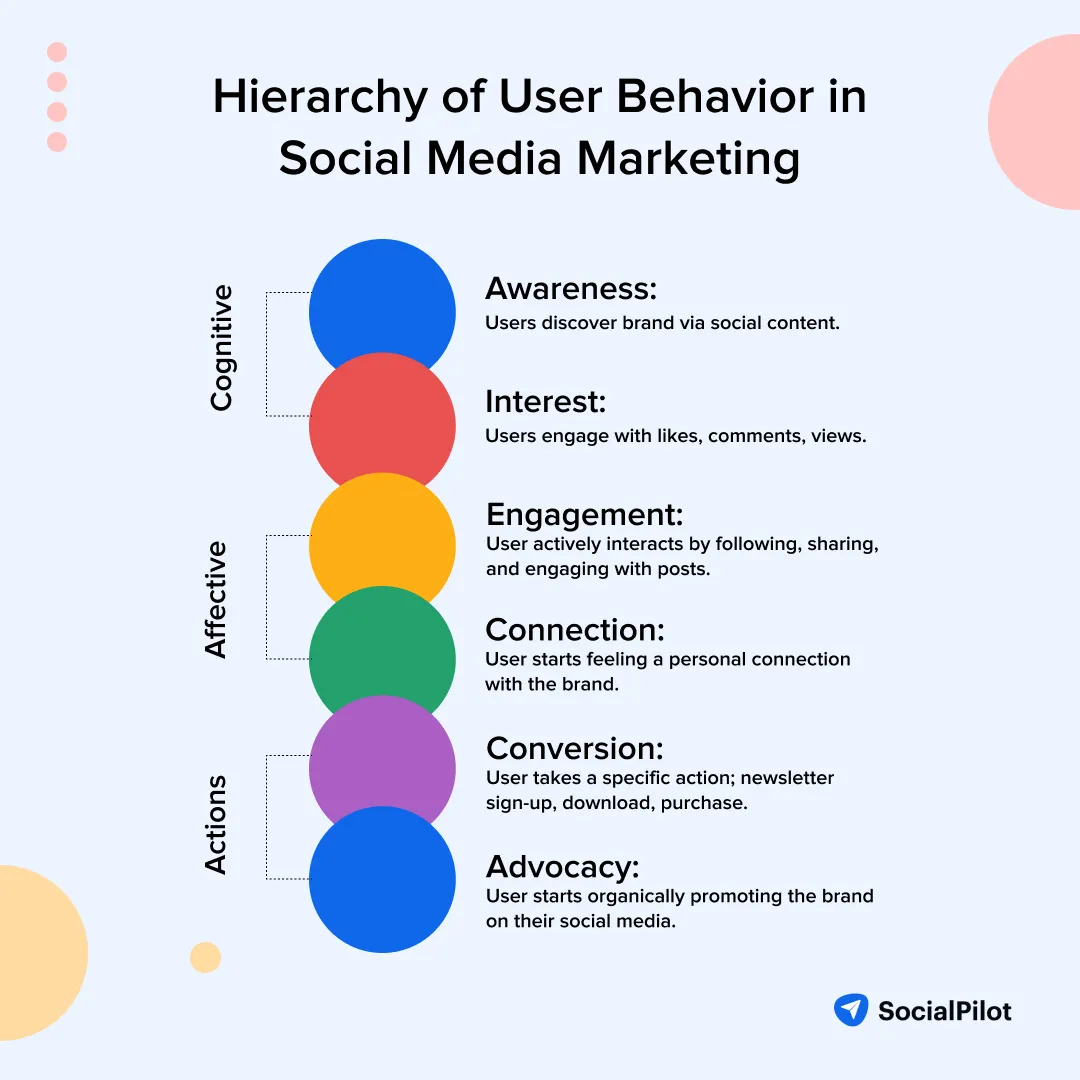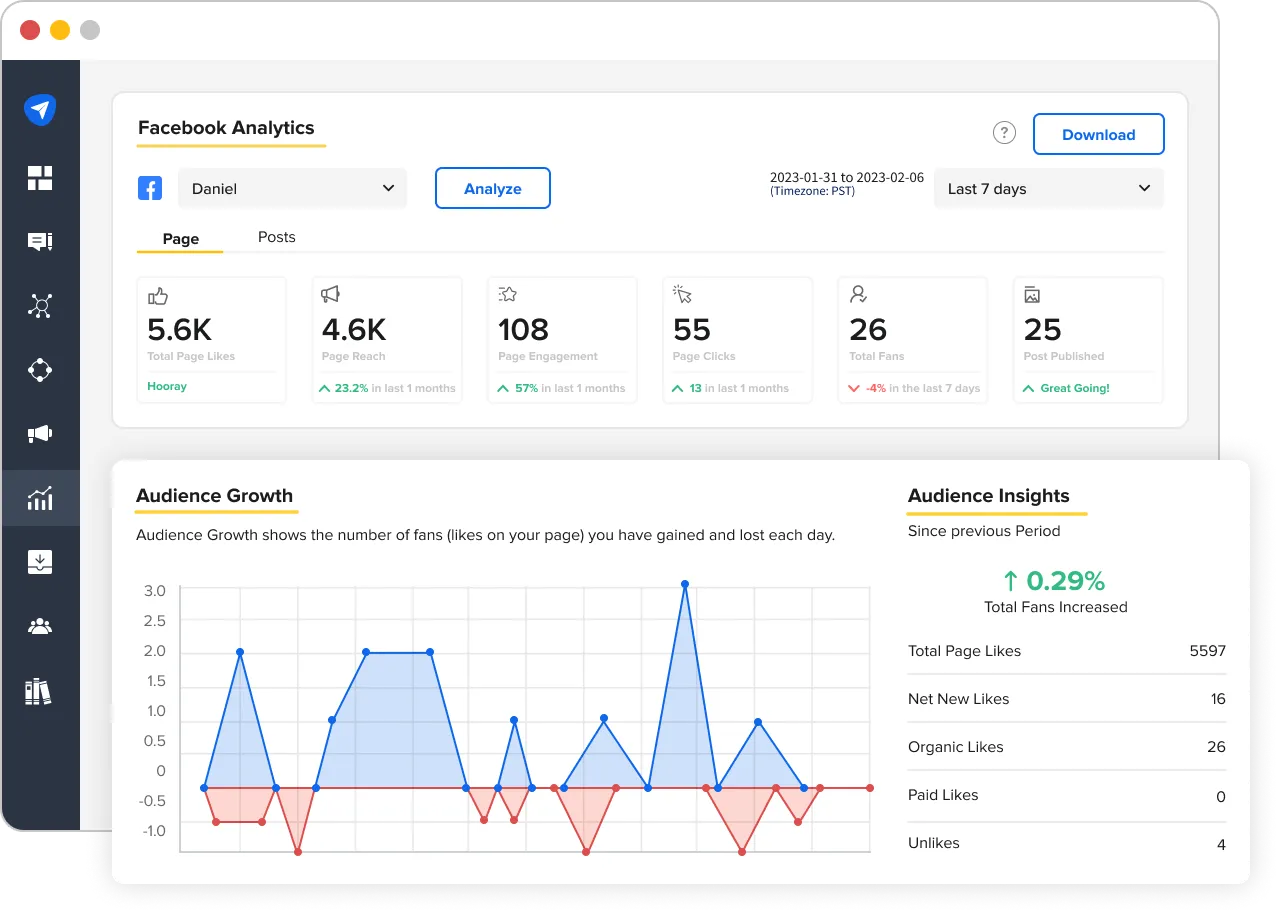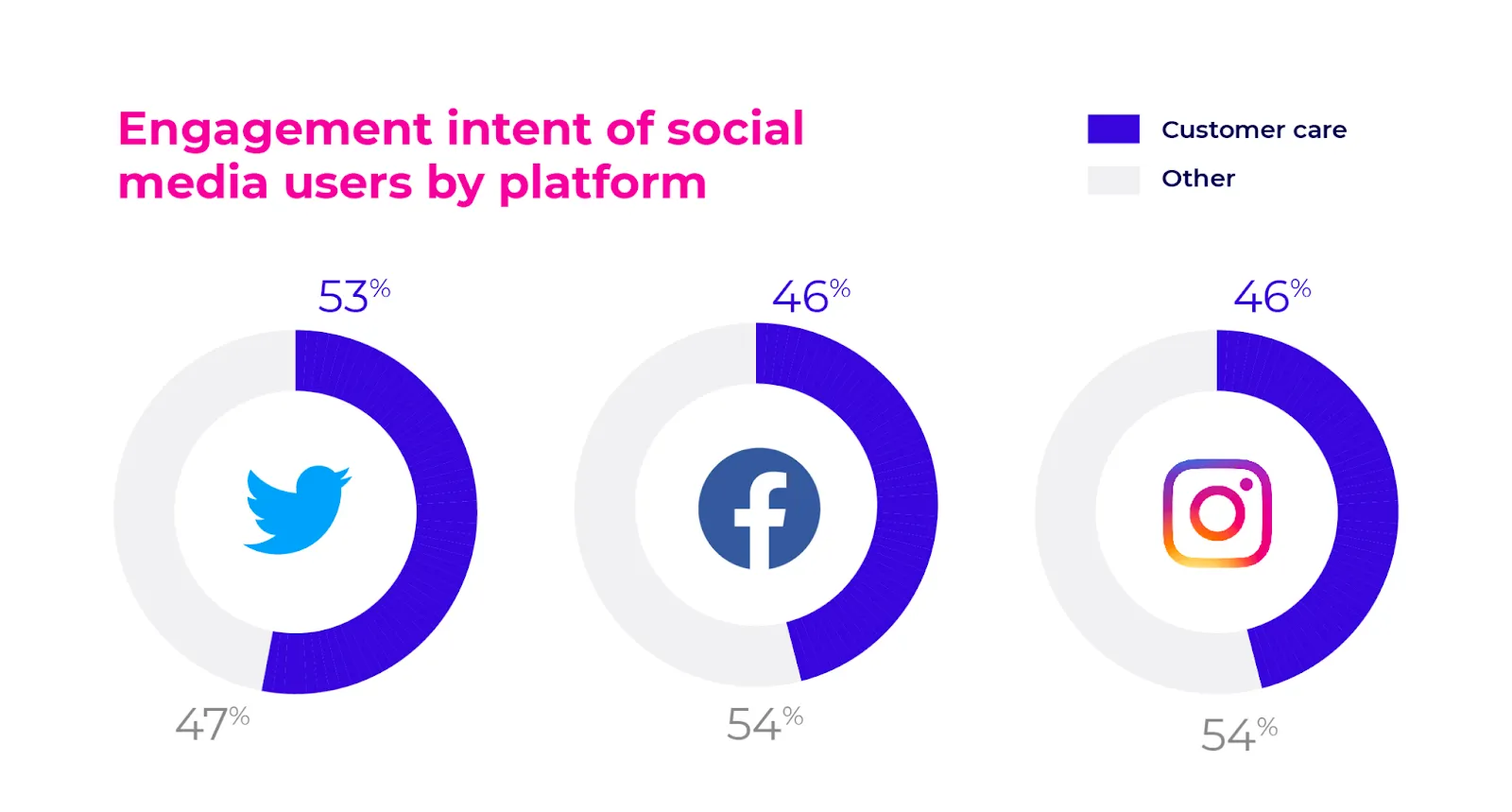Every social media marketing strategy starts with setting up goals for them.
Without them, you can post the snazziest Reels or the wittiest tweets and gain views and followers, but you won’t know if your efforts actually impacted your business.
Many social media marketers struggle with the issue of not setting clear goals before launching campaigns.
Now, they are either chasing vanity metrics or are unaware of social media’s potential to grow their brand and impact overall business goals.
We don’t want you to make that mistake.
That’s why we created this blog to discuss the common social media marketing goals you can target and achieve through social media.
We will take a dive into each social media marketing goal and explore different key metrics to track them. The aim is to show how social media can deliver a measurable ROI far beyond likes and shares for your business.
Now, keep your eyes on the goals!
What are Social Media Goals?
Social media goals are the set of objectives businesses try to achieve through their presence and efforts on social media channels. Some common social goals are increasing brand awareness, generating leads, or boosting brand awareness (scroll down for all!).
These specific objectives stem from a business’s overall marketing goals.
For example, your business goal of “Increasing product Sales by 20% in the Next Quarter” will translate into a goal of “Boost Engagement on Product Promotion Posts by 30% to Drive More Traffic to the Product Page.”
Social media marketing goals also act as milestones you can use to track progress and know whether your social media campaigns and content are working or not.
9 Common Social Media Marketing Goals and How to Track Them
Your social media marketing goal is just a statement. What breathes life into the goals are the metrics you will track.
In this section, as we take you through the common social media marketing goals, we will also cover the key social media metrics associated with each goal and how you can track them effectively.
1. Increasing Brand Awareness
Over 4.95 billion people are present on social media.
The sheer volume of people makes it obvious that social media platforms have the potential to spread your brand’s name to more and more people. And that is what driving brand awareness is essentially.
To some extent, social media has made it possible to quantify brand awareness. Increasing awareness is the number one and most common objective for brands.
Getting your name out there and making a lasting impression on your potential audience lays the groundwork to achieve all the other goals.

Key metrics to track the increasing brand awareness goal:
- Follower growth: Gaining new followers shows your brand’s reach is expanding within social channels. Pay attention to follower numbers across platforms.
- Reach and impressions: This indicates how many people see your content in their feeds. Big numbers mean more eyeballs seeing your brand.
- Share of Voice: Determine how many conversations within your industry are centered around your brand on social media. You need to track the percentage of overall social mentions for the broader industry keywords your brand generates.
- Brand Mentions and hashtags: People mentioning your brand name or hashtags shows people are aware of your presence.
You can use the native analytics section of social media platforms to track your brand awareness metrics. But there is a better option…
Monitoring metrics across different social media channels is a pesky task. There’s an easier way, though!
Use SocialPilot’s analytics feature to unify the analytics of multiple social media channels under one roof. Choose your platform, pick a timeline, and you’ve got every key metric to check how you perform to reach your end goal. No more switching between different analytics tabs!

2. Driving Website Traffic
A bit ironic, but the most important social media marketing goals will not be realized on social media itself.
While social media is where you build your brand and engage with your audience, the real magic happens when you drive them to your website.
Once they’re there, you can focus on goals like capturing leads or making sales(more on these later in the blog).
Key metrics to track the driving website traffic goal:
- Social referral traffic: Use Google Analytics to check the volume of website visitors coming directly from social platforms to your website in a given period of time.
- Click-through rate: The percentage of people clicking on your social media post links and coming to your website or landing page. Higher CTR indicates compelling social media copy and landing page.
- Traffic Quality: Tracking the visitor behavior, such as time spent on the site, pages visited, content downloads, or direct sales, tells you the quality of traffic your post has generated.
3. Driving Revenue Growth
Driving revenue is every social marketer’s goal.
While this is the end goal tied to everything you would do on social media, sometimes you can skip it and jump directly to the sales part.
Nowadays, every social media has features like profile links, shoppable posts, and product tags to reduce friction and enable shopping within the social media environment.
In addition to organic content, you can target direct sales through social media shopping and retargeting ads to get people to sign up for free trials, shop their abandoned cart, or make a new purchase.
However, you should not overdo the self-promotion. Social media is about providing value. Pushing them for purchase every single time might cause them to unfollow.
Key metrics to track revenue-driving social media goals:
- Sales Attributed to Social Media: Using UTM codes to track the number of people who have clicked on the link in your posts to reach a sales landing page and make a purchase.
- Click-through Rate (CTR): Determines the percentage of people who clicked on a link from your social media post and took a desired action, which may or may not have turned into a purchase.
- Bounce Rate: People who have clicked on your post but left without taking any action.
4. Generating Social Media Leads
Most of the time, social media will not drive direct purchases instantly, especially for businesses with longer sales cycles.
That’s when you target the goal of generating leads through social media. It basically means persuading viewers to share their contact information in exchange for something valuable.
You promote posts with a link offering downloadable content, webinar registration, email newsletter signups, or anything that entices audiences enough to click through to landing pages and give their information.
You can later nurture these leads by sending helpful follow-up content to gain their trust. The more value you provide, the better the chances of achieving the aforementioned revenue growth goal.
Key metrics to track generating social media leads goal:
- Click-through Rate (CTR): The percentage of people who read your post, got enticed, and clicked on it to access the gated content. A high CTR indicates compelling messaging.
- Number of Downloads: The number of social media users who ultimately download the content asset you promote after clicking on your post.
- Lead Quality Score: Assigning a score to each lead based on engagement metrics to determine how likely they are to convert.
5. Boosting Brand Engagement
While boosting social media engagement may seem like a vanity goal in front of sales and leads, the truth is that without strong engagement metrics, you will struggle to reach other goals.
Engagement lays the foundation to reach other social media goals. Only the audience that is actively engaging with you will convert into your customers down the line.
Strong engagement means building communities that know, like, and trust you. This happens by consistently providing helpful, exciting content that meets their interests.
Key metrics to track social media engagement goal:
- Likes, comments, and shares: These are the most common ways of interacting on every platform. They indicate how well your content has resonated with the audience.
- Clicks: When a social media user clicks on the link in your post, it indicates they read your content and were compelled to take the next step to click through.
- Engagement Rate: You can find out the exact engagement rate by dividing the total interactions (likes, comments, shares, etc.) on a post by the number of followers who saw the post.
6. Community Building and Management
An engaging social media strategy requires more than posting content every day. The latest social media trends suggest audiences seek close-space connections with brands and creators on social media.
That’s why many businesses aim to gather and engage with people in closed spaces like social media DMs, groups, Twitter chats and spaces, and broadcast channels. Doing so enables them to bond deeper and create loyal social media communities.
Your loyal community becomes the advocates of your brand and products through user-generated content like reviews and referrals. And it’s a fact that nowadays, word-of-mouth marketing works better than branded content.
Key metrics to track community-building goal:
- Community growth and churn: The number of people joining, leaving, and staying in your community over time shows how well your community is growing.
- Community engagement: Measure the interaction of existing community members, such as posting original comments and content, commenting on other posts, liking, sharing, etc.
- Active Members Percentage: A thriving community is where members are actively participating. You measure this by dividing the number of members creating or engaging with content divided by the total number of members.
- Conversion Rate: This indicates how well your community members drive business goals like product sales, newsletter signups, content downloads, event registrations, etc.
7. Enhancing Social Media Customer Service
More and more customers prefer using social media as a support channel. A study by Kohrs shows that over half of consumers engage with brands on social media about customer care concerns.

As people expect you to attend to their queries on social, it’s important to make enhancing social media customer service a priority goal.
People often ask questions out in the open instead of coming to your DMs. Replying faster sends a message that your brand is listening and enhances brand reputation and credibility, while poor service can gravely damage brand image.
Are you finding it hard to respond quickly to customer queries across different social media channels?
Simplify the process with SocialPilot’s universal inbox. Get the comments section and inbox of multiple social media accounts across different channels into a single, user-friendly dashboard. Respond in real-time using engaging images, GIFs, and emojis. Reduce your response time effortlessly!

Key metrics to track social media customer service:
- Response Time: Track the timestamps of a received message to find how quickly your team responds to customer inquiries or complaints on social media platforms.
- Resolution Time: Monitor the average time it takes to resolve customer issues or concerns.
- Customer Satisfaction (CSAT) Score: Gather feedback on customer satisfaction with the support received on social media and, based on that, prepare a CSAT score.
8. Managing Brand Reputation
Managing brand reputation is an overarching goal that can be achieved by gaining insights through social listening and using these insights to drive conversations that benefit your brand’s reputation.
Thanks to social media, brands and customers are closer than ever. You might have seen customers openly discussing their thoughts and concerns about a brand or its products on social media.
And it’s not limited to customer service-related issues. We’re talking about indirect conversations happening across social channels regarding your brand experience, business practices, values alignment, and character as a company.
Sometimes, you engage with them, and sometimes, you learn from them, but every time, you should devise a strategy to steer your brand’s reputation toward a more positive side.
Key metrics to track your brand reputation:
- Sentiment analysis: Understand the sentiment of the conversation about your brand. Is it positive, negative, or neutral? It will help you assess the general feeling towards your brand on social platforms.
- Mention Volume: Track the daily/monthly brand mentions that include direct tags of your brand’s profile, hashtags, or mentions in the text of posts.
- Influencer engagement: Monitoring the number of mentions coming from influencers in your industry. Influencers have the power to sway public opinion significantly.
How to Set SMART Social Media Goals?
Structuring your social media marketing goals within a framework makes a huge difference.
For example, just saying you want to increase brand awareness is a very broad goal! It doesn’t drive action immediately.
You need a goal-setting framework to clarify your goal on a deeper level. It will keep your strategy laser-focused and increase your chances of achieving the end goal.
Mostly, every social media marketer uses the S.M.A.R.T. social media goals framework. The word S.M.A.R.T is an acronym that stands for Specific, Measurable, Achievable, Relevant, and Time-bound.
To better understand, let’s take the above-mentioned vague goal and expand it into a SMART one.
Vague goal: Increase Website traffic from Facebook
Specific
You need to be very specific with your goals. What exactly do you want to achieve? Let’s take the vague goal example mentioned above.
Instead of saying, “Increase Website traffic from Facebook,” say, “Increase website traffic from Facebook by 25% within three months.”
Measurable
Here, the social media metrics we defined for each goal earlier come into play. You will need a few indicators to measure if you are getting closer to or further from your defined target.
So, a measurable SMART goal social media example would be – “Achieve a 25% increase in website sessions originating from Facebook referral traffic within the next three months.”
Achievable
Never set unrealistic goals. Take a look at your past performance, and based on that, come up with a target that is achievable. You can’t aim for an 80% rise in Facebook referral traffic if your previous data show that you have only achieved a 10% increase so far.
Similarly, don’t set your sights too low. You need to be ambitious as well. The key is to Find a balance between attainability and ambition.
Relevant
Your very presence on social media is to drive your overall business goals. Never set your social media marketing goal in a silo. Always look at the big picture.
For instance, you should only choose the goal of increasing website traffic from Facebook when aiming to drive potential leads and conversions. This goal supports the broader strategy of reaching your target audience effectively.
Time-bound
Every goal should have a timeline attached to it. Having a deadline creates a sense of urgency and drives individuals and teams to prioritize tasks and allocate resources efficiently.
Here’s how our example goal looks with a time limit: Achieve a 25% increase in website traffic from Facebook by the end of the next three months
Also, now we have our complete SMART goal ready.
S.M.A.R.T. goal example: Achieving a 25% increase in website sessions originating from Facebook referral traffic within the next three months.
So, What Are Your Social Media Goals?
There you have it!
Goals are the building blocks of your social media strategy. With meaningful SMART goals by your side, you can prove the worth of social media in driving business impact.
While we have given the most common ones, you can shape them into objectives that suit your brand and overall business.
Also, remember that goals and the metrics to measure them vary from platform to platform, so tailor your objectives accordingly.
To effectively track and manage your social media goals across multiple platforms, use a tool like SocialPilot.
Its powerful scheduling capabilities help you execute multiple campaigns carrying different goals across channels from a single dashboard and also let you track performance.
Happy goal-setting!



